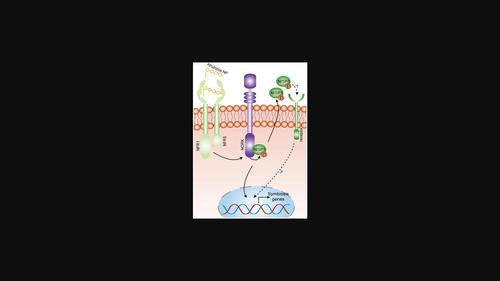当前位置:
X-MOL 学术
›
J. Integr. Plant Biol.
›
论文详情
Our official English website, www.x-mol.net, welcomes your
feedback! (Note: you will need to create a separate account there.)
A novel secreted protein, NISP1, is phosphorylated by soybean Nodulation Receptor Kinase to promote nodule symbiosis
Journal of Integrative Plant Biology ( IF 9.3 ) Pub Date : 2022-12-19 , DOI: 10.1111/jipb.13436
Baolan Fu 1 , Zhipeng Xu 1 , Yutao Lei 1 , Ru Dong 1 , Yanan Wang 1 , Xiaoli Guo 2 , Hui Zhu 1 , Yangrong Cao 1 , Zhe Yan 3
Journal of Integrative Plant Biology ( IF 9.3 ) Pub Date : 2022-12-19 , DOI: 10.1111/jipb.13436
Baolan Fu 1 , Zhipeng Xu 1 , Yutao Lei 1 , Ru Dong 1 , Yanan Wang 1 , Xiaoli Guo 2 , Hui Zhu 1 , Yangrong Cao 1 , Zhe Yan 3
Affiliation

|
Nodulation Receptor Kinase (NORK) functions as a co-receptor of Nod factor receptors to mediate rhizobial symbiosis in legumes, but its direct phosphorylation substrates that positively mediate root nodulation remain to be fully identified. Here, we identified a GmNORK-Interacting Small Protein (GmNISP1) that functions as a phosphorylation target of GmNORK to promote soybean nodulation. GmNORKα directly interacted with and phosphorylated GmNISP1. Transcription of GmNISP1 was strongly induced after rhizobial infection in soybean roots and nodules. GmNISP1 encodes a peptide containing 90 amino acids with a “DY” consensus motif at its N-terminus. GmNISP1 protein was detected to be present in the apoplastic space. Phosphorylation of GmNISP1 by GmNORKα could enhance its secretion into the apoplast. Pretreatment with either purified GmNISP1 or phosphorylation-mimic GmNISP112D on the roots could significantly increase nodule numbers compared with the treatment with phosphorylation-inactive GmNISP112A. The data suggested a model that soybean GmNORK phosphorylates GmNISP1 to promote its secretion into the apoplast, which might function as a potential peptide hormone to promote root nodulation.
中文翻译:

一种新型分泌蛋白 NISP1 被大豆结瘤受体激酶磷酸化以促进根瘤共生
结瘤受体激酶 (NORK) 作为 Nod 因子受体的共同受体来介导豆科植物的根瘤菌共生,但其积极介导根结瘤的直接磷酸化底物仍有待充分鉴定。在这里,我们鉴定了一种 GmNORK 相互作用小蛋白 (GmNISP1),它作为 GmNORK 的磷酸化靶标来促进大豆结瘤。 GmNORKα 直接与 GmNISP1 相互作用并磷酸化。根瘤菌感染大豆根和根瘤后, GmNISP1的转录被强烈诱导。 GmNISP1编码含有 90 个氨基酸的肽,其 N 末端有一个“DY”共有基序。检测到 GmNISP1 蛋白存在于质外体空间中。 GmNORKα 磷酸化 GmNISP1 可以增强其向质外体的分泌。与用磷酸化失活的 GmNISP1 12A处理相比,用纯化的 GmNISP1 或磷酸化模拟 GmNISP1 12D对根部进行预处理可以显着增加根瘤数量。数据表明,大豆 GmNORK 磷酸化 GmNISP1 以促进其分泌到质外体中,这可能作为一种潜在的肽激素来促进根结瘤。
更新日期:2022-12-19
中文翻译:

一种新型分泌蛋白 NISP1 被大豆结瘤受体激酶磷酸化以促进根瘤共生
结瘤受体激酶 (NORK) 作为 Nod 因子受体的共同受体来介导豆科植物的根瘤菌共生,但其积极介导根结瘤的直接磷酸化底物仍有待充分鉴定。在这里,我们鉴定了一种 GmNORK 相互作用小蛋白 (GmNISP1),它作为 GmNORK 的磷酸化靶标来促进大豆结瘤。 GmNORKα 直接与 GmNISP1 相互作用并磷酸化。根瘤菌感染大豆根和根瘤后, GmNISP1的转录被强烈诱导。 GmNISP1编码含有 90 个氨基酸的肽,其 N 末端有一个“DY”共有基序。检测到 GmNISP1 蛋白存在于质外体空间中。 GmNORKα 磷酸化 GmNISP1 可以增强其向质外体的分泌。与用磷酸化失活的 GmNISP1 12A处理相比,用纯化的 GmNISP1 或磷酸化模拟 GmNISP1 12D对根部进行预处理可以显着增加根瘤数量。数据表明,大豆 GmNORK 磷酸化 GmNISP1 以促进其分泌到质外体中,这可能作为一种潜在的肽激素来促进根结瘤。

































 京公网安备 11010802027423号
京公网安备 11010802027423号